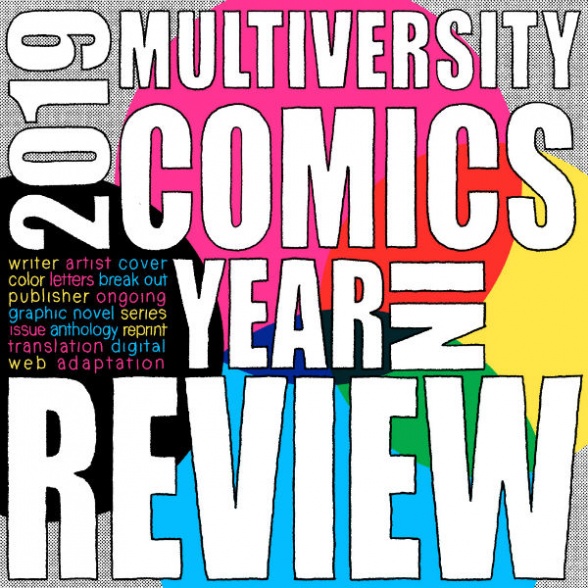
Over the past 20 years, comics have become more and more of a writer’s medium. There are pros and cons to this, but the eleven writers we feature here have each found ways to tell their stories in interesting and creative ways. This list covers folks doing superhero work at the Big 2, creator owned work, graphic novels, licensed work, and everything in between.

10 (tie). Kelly Thompson
Kelly Thompson gave us Jeff the land shark. That alone is qualifying for Best Writer.
Okay, I’m being informed that I need to provide more reason than just one line, so here we go.
Jeff the land shark, while a wonderful addition to Marvel comics, is only an example of what Kelly Thompson’s writing brings to the table for any book she’s working on. Her works bring a fantastic blend of humor, character work and action that keep them entertaining from the first page to the last. All the while she expands on the world and adding stakes for the characters that feel natural and important.
Take, for instance, her work on “Captain Marvel.” Under her pen, Carol has fought in a post-apocalyptic Battle of the Sexes, explored her dual identity as human and Kree, and gained new allies and enemies alike. All the while, the comic is enhanced with narration and dialogue with strong voices and no small amount of wit and heart.
But of course, we need to talk about “West Coast Avengers,” and not just because of Jeff (but he is a big reason too). She assembled a team that blended fan favorites and new characters, gave each of them strong chemistry with one another, and made them work together as a team against threats you could only find in the west coast. Each issue was a joy to read, filled with heart and hilarity that made us root for the team and watch them grow. Where else could we find Gwenpool, Quentin Quire, and both Hawkeyes working together?
While it’s too soon to say much about her new run on “Deadpool,” since it just began, the first issue is just as promising. In this case, we’re getting Deadpool, Elsa Bloodstone, and of course, Jeff on an island of monsters – at this rate, 2020 is looking pretty good for Kelly Thompson as well. – Robbie Pleasant
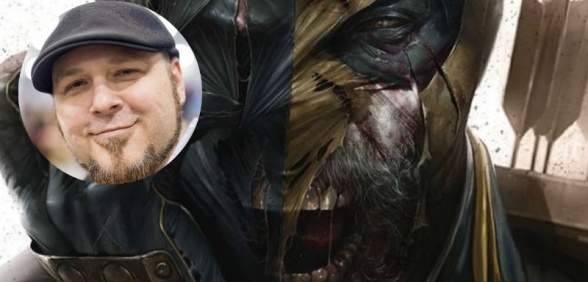
10 (tie). Tom Taylor
Tom Taylor’s incredible ability to create larger-than-life storylines in just a few issues doesn’t go unnoticed. “DCeased” is a great example of what Taylor is capable of. In six issues he conveyed what it is to have greatness thrust upon those who are not ready to accept the responsibility. He took the characters we all know and demonstrated that, even when they’re gone, there is always a way forward. In other words, he made us feel. He makes his readers feel connected and that level of connectivity is ultimately what we search for when we pick up a comic book.
Let us not forget that he also kicked off the “Friendly Neighborhood Spider-Man” series and nailed a good solid beginning for such an iconic hero is no easy feat. I would agree that 2019 has been a good year for Tom Taylor, along with 2018 and 2017 before that. I think 2020 will also be the year of Tom Taylor. – Hugo Gomez-Vivas

9. Donny Cates
As 2019 comes to an end, Donny Cates proves yet again that he’s one of the best writers in comics currently. After Cates made his way into Marvel with his impressive indie work, he has continued to amaze readers and to push the limit of his creative ability with established characters that we all know and love.
Cates was one of the many masterminds behind one of the biggest events of the year, “Absolute Carnage,” which spanned 29 issues, including the tie-ins. “Absolute Carnage #1” alone demonstrates the kind of spectacle Cates can build, and how he can establish tone and mood in a single page. Not only is the series incredibly cinematic and character-driven, but it’s also genuinely frightening and eerie, one of Cates’s many strong suits. “Absolute Carnage” gives us a ton of insight into Eddie Brock as a character and also begins to flesh out Dylan Brock, introduced in “Venom,” who has quickly become a fan favorite despite the mystery that still lies in who Dylan really is. The five-issue event answers questions we’ve had, but raises even more, leaving the excitement for upcoming “Venom” issues at an all-time high. Accompanying these two major books this year are Cates’s run on “Guardians of the Galaxy,” which wraps up in December, and “Silver Surfer: Black,” another five-issue miniseries that poetically and humanely explores a whole new side of Norrin Radd as he is pitted up against Knull, a major threat that Cates has brought into the universe and continues to explore in “Venom.”
Continued belowLastly, Cates continues to accomplish his signature, supernatural, creepy tone in his Image book, “Redneck,” which just wrapped up its fourth arc this year with issue #24, and his Aftershock book, “Babyteeth.”
Every year, Cates juggles many different books across many different publishers while keeping each and every series fresh, unique, and entertaining, which is reason enough to include him on this list. – Evan Tyler-Johnson

8. Tini Howard
Tini Howard launched onto the scene a couple years ago, chiefly through IDW/Shelly Bond’s now defunct and sorely missed ‘Black Crown’ imprint. It’s not too bold to say that each of Howard’s ‘Black Crown’ books was a clear stand-out of the line. Through that imprint, she quickly honed her craft and emerged as the one of freshest, most exciting talents in the last few years of writing in comics. She very quickly became one of those creators whose projects I would follow and give a chance to based on her name being on the cover alone.
Last year, I would have regarded her as the breakout writer of the year, and since then the expansion of her career has been rapid and well-deserved, quickly asserting herself among Marvel Comics’ regular stable of talent with an exclusive contract and a list of half a dozen Marvel projects to her name in this year alone. At Marvel, she was tasked with writing a Thanos book that happened to coincide with the release of the biggest Marvel movie in history featuring the Mad Titan as the villain. How’s that for pressure? The series chiefly re-visited the history and the nature of the relationship between Thanos and his daughter Gamora, which was of course one of the central conflicts of the film too. I’d say that says all you need to know about Marvel’s trust in Tini Howard’s talent. Her Bêlit book spinning out of Marvel’s ‘Age of Conan’ relaunch switched up the tone of Conan’s sometimes stuffy presentation, centering a youthful, swashbuckling story around Conan’s pirate paramour. But those were only an appetizer for what would be coming later.
My favorite unique feature of Howard’s writing fully revealed itself when the trio of “Death’s Head,” “Strikeforce,” and “Excalibur” hit the stands: namely, her ability to juggle a cast of characters, giving them a variety of voices, authentic personalities, realistic points of view, and unique senses of humor. This is what made her ‘Black Crown’ work so memorable and engaging, and it’s what has made “Excalibur” one of the best ‘Dawn of X’ titles, as well. “Death’s Head” takes an oddball Marvel UK character and folds him into a story with Wiccan and Hulkling of the Young Avengers. She would carry Wiccan into “Strikeforce,” mixing some of Marvel’s strangest superhero side-characters and seeing how they bounce off of one another. Likewise, “Excalibur” juggles a team of X-characters (some unlikely to mesh well with the others, but Howard navigates it beautifully) into a complex story and makes it go down easy. As a side note, her derivation of Jonathan Hickman’s infamous infographic pages are probably the most useful and most faithful ones when it comes to meeting his original vision for them in the X-Men books thus far. This ability to iterate on an existing idea while adding in her strong creative voice is proof positive that Howard is a perfect fit for Marvel: she knows just how to take their scattered history of misfit characters and weave them into something greater than their individual pieces. – Vince Ostrowski
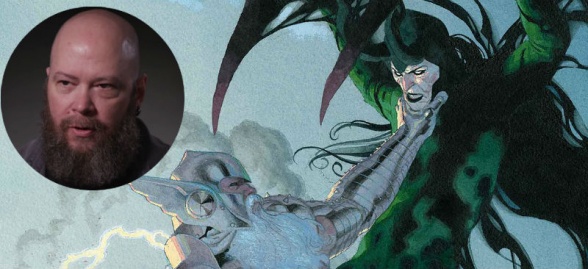
7. Jason Aaron
In 2012, my friend messaged me out of the blue with the following text, “Marvel NOW is happening NOW. You should read Jason Aaron’s ‘Thor.’” It was a fantastic recommendation. Jason Aaron’s run on “Thor” was the first time I followed an ongoing comic series. It was also the first time I started following the career of a writer, choosing comics I might otherwise have skipped because Jason Aaron was writing them. Jason Aaron had a big year in 2019, successfully wrapping up his Thor epic, being given the reigns of Earth’s Mightiest Heroes, reintroducing Conan to Marvel, as well as working on some personal projects. It was a good year to be a Jason Aaron fan.
Continued belowAaron’s writing can sometimes feel a little reminiscent of European Power Metal. It’s big and epic, but has a healthy sense of humor. Aaron is unafraid to embrace the over the top nature of the superhero genre. While others decide decide to simplify costumes or power levels, Aaron created a Ghost Rider who’s mount is a motherfucking flaming mammoth. If you can imagine it on the side of a metal van, it would probably fit well into a story by Jason Aaron.
But the trick with Aaron is that he’s not simply bombast and over the top epic. One of the things that makes Aaron resonate is his depiction of masculinity. Aaron’s characters are big and beardy. They love to fight, drink, and bellow about their victories. But these characters also have deep emotions, or learn to accept their emotions. They have moments of true vulnerability. In many ways this comes across best in Thor Odinson’s journey of what it means to be worthy. Thor’s “worthiness” made him arrogant, hot headed, sometimes cruel. As the god of the unworthy he knows what it means to be vulnerable, afraid, and unwanted. Is it perfect? No, but it feels important for the world we live in.
Finally, Aaron successfully stuck the landing on the “Thor” comic from all those years ago. Finishing anything that long term in a way that is satisfying is difficult, but Aaron made it look almost effortless. It was sprawling and triumphant, weaving in characters from throughout Marvel in a way that felt necessary and not gratuitous. It’s safe to say that Aaron’s run of Thor will be nothing short of definitive, something that people will point to as one of the greats. While Aaron might be done with Thor, he is still one of the major architects of the Marvel Universe. I’m excited to see where they go with him at the helm! – Joe Skonce
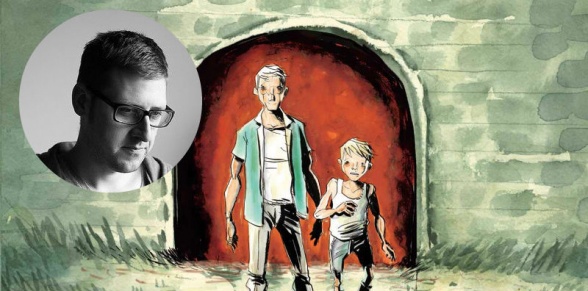
6. Jeff Lemire
This year marked an exciting turning point for Jeff Lemire. He stepped away from doing any long-term Marvel or DC books to focus on creator-owned work. (If you’re a fan of his company-owned works, don’t worry, he’s still working with Marvel and DC, just shorter stints.) Simply put, this means Jeff Lemire doing more of the stuff that’s distinctly Jeff Lemire. “Black Hammer: Age of Doom,” “Ascender,” “Sentient,” and “Gideon Falls”—each of these was nothing less than fantastic, and that’s where his focus is going to be going forward.
No matter what his stories are about, Lemire is always curious about the interior lives of his characters, and this is what gives such a spark to his work—and his collaborators fan than spark into a blaze. Look no further than “Gideon Falls” to see how Andrea Sorrentino takes the interior worlds of its characters and turns them into stunning visuals, which are constantly evolving and twisting and ripping open. This element of taking the interior and making it transform the exterior is perfect for comics, and you see it again and again in Lemire’s work.
But best of all, this year sees Lemire consciously carving out more time for his personal projects he’s both writing and drawing. This is the most exciting change about Lemire’s work in 2019. “Royal City,” which ran from 2017 to 2018, was a series that I loved, but Lemire struggled to find time to work on it and ultimately came to the conclusion that because of this it fell short of his goals. Now he’s working on OGNs, freeing himself from the monthly grind of an ongoing title, and giving himself the space to develop his work without having to sacrifice a commitment to a collaborative project. This year’s “Frogcatchers” was the first book we got out of this and he’s already completed another and he’s hard at work on a third. Lemire’s had an excellent 2019, and I can’t imagine a more exciting prospect for Lemire’s work as we head into 2020. – Mark Tweedale

5. Chip Zdarsky
Chip Zdarsky is one of the most surprisingly reverential writers in comics right now. “Spider-Man: Life Story” captured a perfect mix of emotional resonance and century-spanning relevancy that hasn’t been distilled this well since Kurt Busiek and Alex Ross did “Marvels”. He writes an enduringly introspective Spider-Man who is somehow both ignorantly naive and tragically jaded.
Continued belowZdarsky also branched out a lot in his genre-heavy creator-owned material, with a portrayal of the (accurately) satanic gig economy in “Afterlift” and in his hot dad fantasy series “The White Trees” where he writes relatable and flawed protagonists from the ground up who are drenched in contradictory insecurity and stoicism. This carries over into “Invaders” where Zdarsky has morphed Namor into an anti-villain who is at his most compelling since Johnathan Hickman’s “New Avengers.” He also got to write an amazing new Howard the Duck story in “War of the Realms: War Scrolls” that filled the cyborg-cat shaped hole in my heart.
To me, “Daredevil” is Chip Zdarsky’s crown jewel of 2019. It followed on organically from Charles Soule’s ‘Death of Daredevil’ and Jed MacKay’s “Man Without Fear” by embracing the obvious pain that human-pin-cushion Matt Murdock goes through as Daredevil. This has been a genuinely revolutionary run on the character with Zdarsky taking the best elements from the character’s mythos like Frank Miller’s self-destructive Daredevil and the Netflix show’s desire to pulp Matt Murdock’s face against every street gutter and lamp post in Hell’s Kitchen, all with a garnish of fallibility, self-doubt, and Catholic guilt.
The mind of Chip Zdarsky is a beautiful masterpiece full of subversive characters, moral dilemma and a deeply passionate hatred for Ryan Stegman that I can’t help but love. Thank you Chip, you taught me how to look beyond my flaws (and how to do Quisping). Seeya next year. – James Dowling

4. Brian Michael Bendis
A year and a half into his run at DC Comics, Brian Michael Bendis continues to prove that the best DC stories are built on heart. His consistent, earnest approach to DC’s stable of characters shows that he understands exactly how the DC Universe works – and what makes it enjoyable for readers.
Like all best versions of the DCU, Bendis’s is full of joy. It contains a truth-telling Superman, a dinosaur-loving Batman, and exciting new faces like Naomi and Jinny Hex. It contains a surplus of mystery, wonder, friendship, and romance. And as of November, it even (once again) contains a canonically bright future.
But if there is one thing that Bendis does even better than writing with heart, it is prompting career-level work from his collaborators. There is no other writer I can think of who drew so much talent out of so many and so varied a set of co-creators this year. David Mack on “Cover,” Kevin Maguire on “Superman,” Jamal Campbell on “Naomi,” Alex Maleev on “Event Leviathan” – Bendis somehow wrote superbly and differently for them all (and many others). And when he wasn’t busy occasioning top-notch artistic work, he was also leading the charge on both his wonderful Wonder Comics imprint and the newly-expanded Superman line.
TL;DR – Brian Michael Bendis is having a blast writing new characters and collaborating with old friends at DC Comics – and it sure showed in 2019. – Matt Ledger
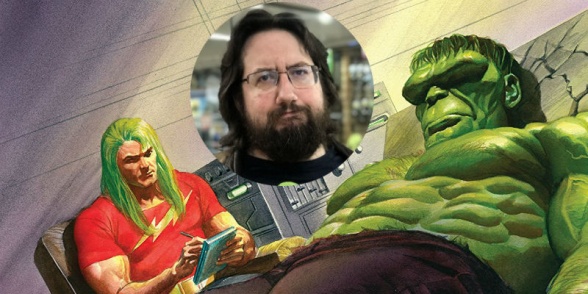
3. Al Ewing
Al Ewing is not Alan Moore, but . . .
You’d be forgiven if you were a little confused on the subject, seeing as to how both are British comic book writers who cut their teeth on scripts for the British weekly sci-fi anthology 2000AD before eventually finding mainstream success in the American comics market by recontextualizing a green horror monster tucked inside a larger superhero universe at one of the Big Two publishers.
Al Ewing is not Alan Moore, but . . .
They do both have the same first name.
Al Ewing is not Alan Moore, but . . .
They do share an uncanny ability to embrace the strangeness inherent in those universes. Both writers see where two loose ends can be tied together, sewing leftover or discarded ideas into a net strong enough to catch bounty after bounty of wonderful ideas. Ewing’s Immortal Hulk marries Moore’s reconstructionist Swamp Thing bent with enough of an eye to the character’s lineage and legacy to make James Starman Robinson proud.
Al Ewing is not Alan Moore, but . . .
They both seem to share an aversion to barbers.
Al Ewing is not Alan Moore, but . . .
Continued belowAt the rate he gets namechecked on lists like these, spinning superhero straw into comics gold (either solo or when working with Jason Aaron on Valkyrie or Marvel Comics / Spider-Man: Full Circle / Incoming with, well, everyone) . . .
It’s getting harder and harder to tell them apart. – Greg Matiasevich
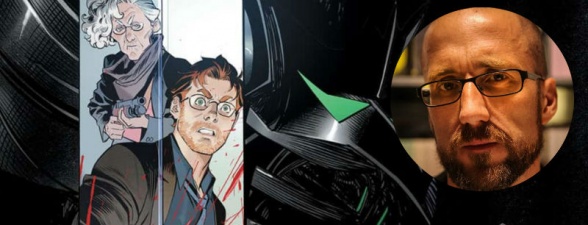
2. Kieron Gillen
Since his debut, you’d be hard pressed to find a year that Kieron Gillen wasn’t doing some of the best work of the year. His books consistently top these sorts of lists. But there is no denying that in 2019 Gillen had a historic run of it, the likes of which will be hard to beat for any comic creator. It’s not just that he consistently did good work, he did good work at every level a comic writer can do good work. He worked with some of the biggest characters of all time, and also his own creations. He ended one smash hit series, and started another one. He was the proverbial Alpha and Omega of 2019.
Not convinced? Let’s look at the work. First you must consider “The Wicked + The Divine,” one of the biggest creator-owned comics of the decade, which ended its run in a phenomenal, emotional fashion. (I wrote extensively about the last run of issues). Then there is “Die,” his new creator-owned Image series, already a colossal hit beloved by fans and critics. Not content to do independent books for just one publisher, Gillen also collaborated with the superb Caspar Wijngaard in “Peter Canon: Thunderbolt” and the similarly outstanding Dan Mora with “Once and Future” (both from BOOM). On top of that, he wrote a fantastic run of “Star Wars” comics (published by Marvel), proving that his style works on every scale.
And what is that style? Gillen has always felt too clever by half, with economical writing that does its best to work on as many levels as possible. A music reference isn’t just a music a reference; it’s also a character beat of staggering heartbreak and a pun of staggering stupidity. He brought that writing talent into “Star Wars,” with ideas that called from the massive series’ history, and in “Die,” which draws from Tolkien, William Gibson, and Vampire the Masquerade.
The best comic writers are also the best collaborators, and it is no surprise that Gillen has consistently worked with the best. Stephanie Hans, Jamie McKelvie, Matt Wilson and Clayton Cowles are all regular features on our best of the year lists. Mora and Wijngaard do phenomenal work. If you’ve had the pleasure of meeting Gillen, you know he can be a chatty guy. But in his work, you see the opposite: he’s the writer who has the wisdom to shut up and step out of the spotlight. Gillen in 2019 is going to be shorthand for a successful year in comics for a long time, and I hope to find myself saying the same thing at the end of 2020. – Jake Hill

1. Jonathan Hickman
You had to have seen this coming right? If not it shouldn’t be any surprise. Yes folks, Jonathan Hickman has been crowned by the staff of Multiversity Comics as Best Writer of 2019.
What can I say about Hickman in about 500 words that the Internet haven’t already said this year? Probably not much. As you are all keenly aware, the tiny comics corner of Twitter went wild every week when a new issue of “House of X” and “Powers of X” came out this summer. For 12 weeks straight (13 really since “X-Men” #1 came out right after “Powers of X” #6) there was rampant speculation on just what in the world was going on on Krakoa. Theories abounded. Theories are still abounding. The new X status quo sparked the most excitement that I have seen about ny comic series. And that remarkable fact right there is why Hickman is our number one this year.
HoXPoX is brilliant. I don’t need to tell you that. Everything about those issues was expertly crafted and succinctly and meticulously executed. What Hickman, Pepe Larraz, RB Silva, Tom Muller, Marte Gracia, Clayton Cowles, and everyone else involved in these books accomplished has set a new standard for what can be achieved in the reading experience of a 40-page comic. There is such a sense in all 12 of those issues, and the little of Dawn of X we’re getting before the decade wraps, that there is a larger plan and it’s thorough and systematic. More than a year has gone into planning everything that is happening and you can see that completely throughout the X-line. And Hickman, the Head of X himself, is captaining the ship.
The new status quo for the X-Men has rocketed Marvel’s mutants into their most important role in decades. Krakoa has been dissected and examined already from so many perspectives and disciplines. Commentary has ranged from talking about white nationalism to just commenting on how horny the X-Men really are and should be (and can be when they have a whole island to themselves). There’s a mutant language and seeds for stories for years to come, as well as a way for death to no longer be the diminishing shock and awe it has become in cape comics. All of this is not to mention the work that Hickman has done this year elevating the character Moira McTaggart to the now ruling trinity of her, Xavier, and Magneto. And of course, the signature data pages from Hickman’s creator-owned work have migrated to the Dawn of X line (thank you Tom) adding depth to every issue and further encouraging the re-readability of these comics. There is so much to learn, so much to dissect, so much we still don’t have or know. That is the fun of reading cape comics, or any story really. There is suspense. We aren’t supposed to know everything. But God do we want to.
So here we are then at the end. By year’s end, Hickman will have written 12 issues of HoXPoX, 7 issues of Dawn of X books while overseeing the other 17, some other one-offs for Marvel, and concluded “East of West” at Image Comics (which other people far more qualified than I have written about over the years). More than that though, Hickman has been the key to reigniting a franchise that has too long dwelled in nostalgia and fed on stories of yesteryear. While all of pop culture seems determined to reboot the hell out of your child and improve upon every franchise of the last 50 years, we have been reminded once again that the best stories are the ones that look back to look ahead. They are the ones that cause us to reexamine our assumptions about what’s possible and rewire our brains to seek new futures, new horizons, new fears, and new hopes. That is the success of HoXPoX. That has been the success of Jonathan Hickman and the uncanny Dawn of X team. – Kevin Gregory






